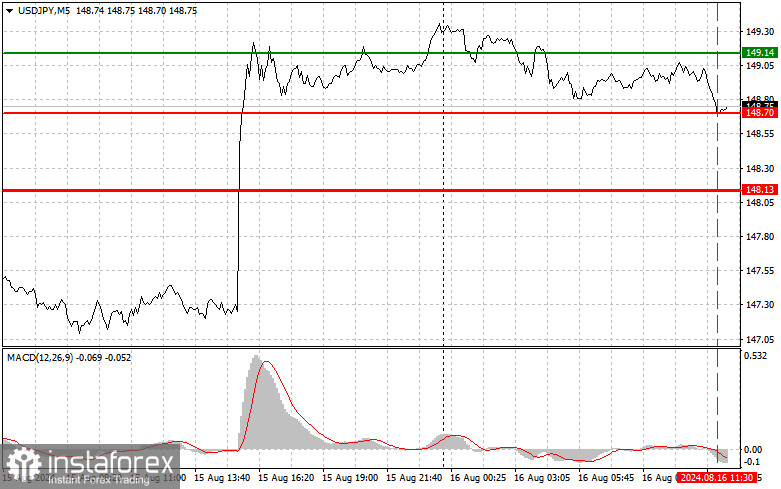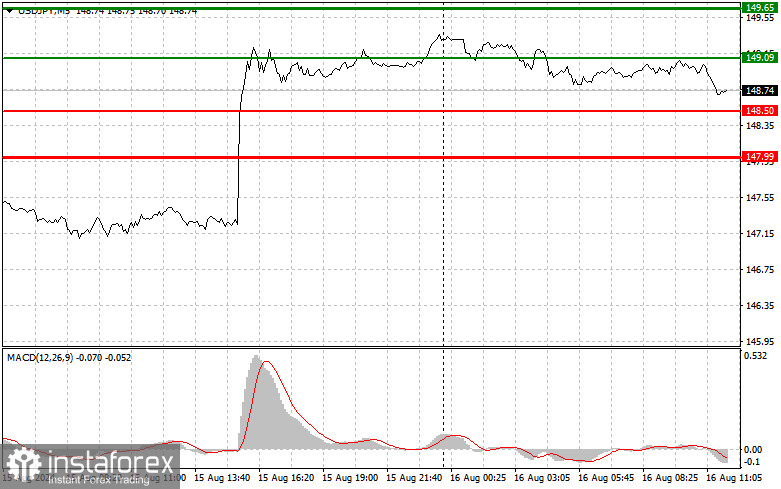Analysis of Trades and Tips for Trading the Japanese Yen
The test of the 148.70 price level occurred when the MACD indicator had already moved significantly downward from the zero mark, limiting the pair's further downside potential. For this reason, I decided not to sell the dollar and stayed out of the market, planning to find new entry points after thoroughly revising my trading plan for the second half of the day. During the U.S. session, we expect several reports that could support the dollar, provided that the data comes in better than economists' forecasts, similar to yesterday's U.S. retail sales figures. The reports will include the number of building permits issued, housing starts, and the University of Michigan Consumer Sentiment Index. A speech by FOMC member Austan D. Goolsbee is also scheduled, which could impact market sentiment. Dovish statements could lead to a decline in the dollar. As for the intraday strategy, I plan to follow scenarios No. 1 and No. 2.

Buy Signal
Scenario No. 1: Today, I plan to buy USD/JPY upon reaching the entry point around 149.09 (green line on the chart), aiming to rise to the 149.65 level (thicker green line on the chart). Around 149.65, I will exit the purchases and open sales in the opposite direction (targeting a move of 30-35 points in the opposite direction from this level). The pair is expected to rise today following positive news from the U.S. Note: Before buying, ensure that the MACD indicator is above the zero mark and just beginning to rise from it.
Scenario No. 2: I also plan to buy USD/JPY today in case of two consecutive tests of the 147.50 price when the MACD indicator is in the oversold area. This will limit the pair's downside potential and lead to a market reversal upward. A rise to the opposite levels of 149.09 and 149.65 can be expected.
Sell Signal
Scenario No. 1: I plan to sell USD/JPY today after the 148.50 level (red line on the chart) is updated, which will lead to a rapid decline in the currency pair. The key target for sellers will be the 147.99 level, where I will exit the sales and immediately open purchases in the opposite direction (targeting a move of 20-25 points in the opposite direction from this level). Pressure on the pair will return if the statistics are weak. Note: Before selling, ensure that the MACD indicator is below the zero mark and just beginning to decline from it.
Scenario No. 2: I also plan to sell USD/JPY today in case of two consecutive tests of the 149.09 price when the MACD indicator is in the overbought area. This will limit the pair's upside potential and lead to a market reversal downward. A decline to the opposite levels of 148.50 and 147.99 can be expected.

Key Chart Elements:
- Thin green line: The entry price at which the trading instrument can be bought.
- Thick green line: The assumed price where you can place Take Profit or manually fix profits, as further growth above this level is unlikely.
- Thin red line: The entry price at which the trading instrument can be sold.
- Thick red line: The assumed price where you can place Take Profit or manually fix profits, as further decline below this level is unlikely.
- MACD Indicator: When entering the market, it's important to consider the zones of overbought and oversold conditions.
Important: Beginner traders in the Forex market need to be very cautious when making decisions to enter the market. Before the release of important fundamental reports, it is best to stay out of the market to avoid getting caught in sharp price fluctuations. If you decide to trade during news releases, always set stop orders to minimize losses. Without setting stop orders, you can quickly lose your entire deposit, especially if you do not use money management and trade in large volumes.
And remember that successful trading requires a clear trading plan, similar to the one I presented above. Making spontaneous trading decisions based on the current market situation inherently leads to losses for intraday traders.





















